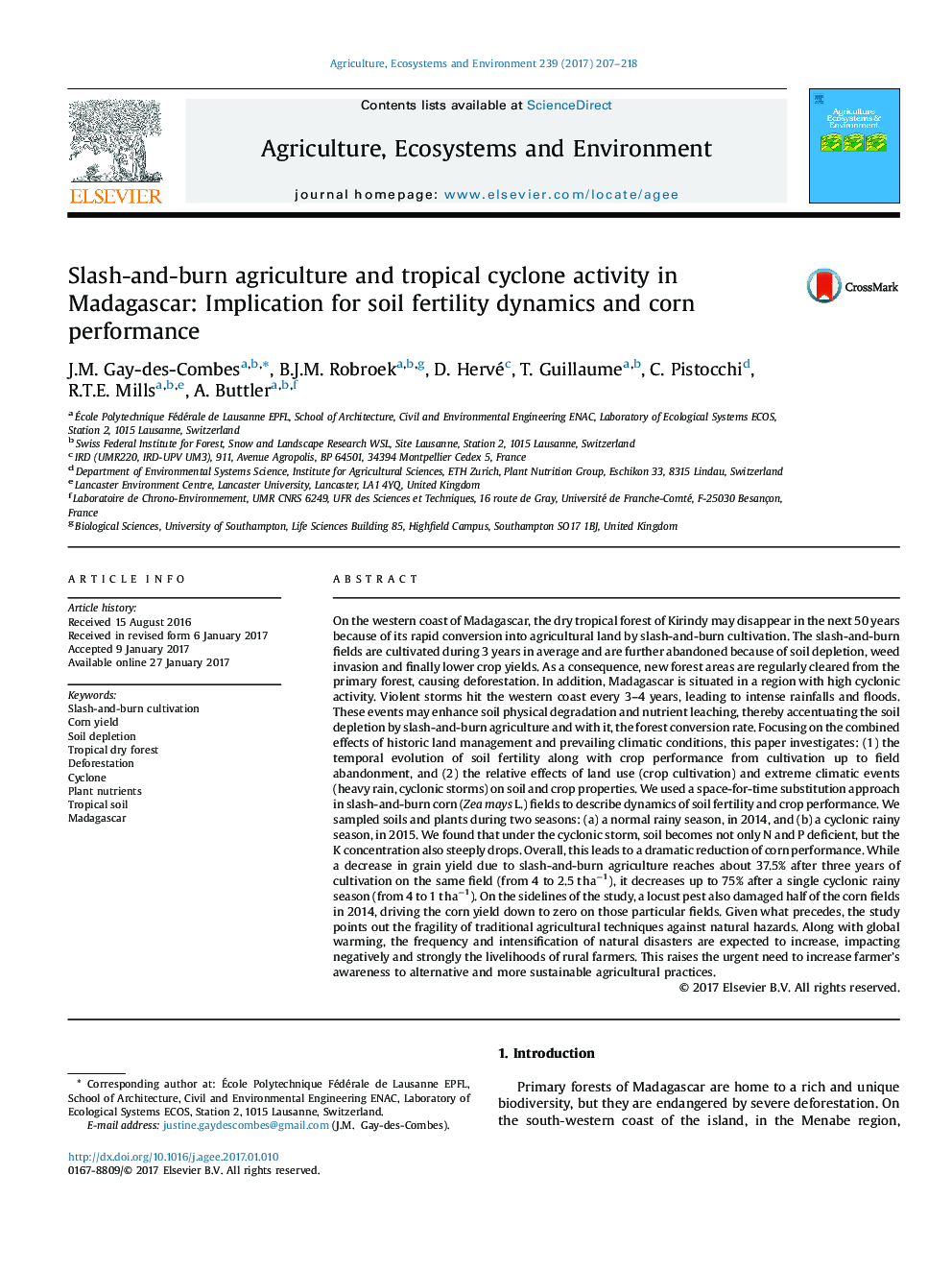| کد مقاله | کد نشریه | سال انتشار | مقاله انگلیسی | نسخه تمام متن |
|---|---|---|---|---|
| 5537927 | 1552013 | 2017 | 12 صفحه PDF | دانلود رایگان |
عنوان انگلیسی مقاله ISI
Slash-and-burn agriculture and tropical cyclone activity in Madagascar: Implication for soil fertility dynamics and corn performance
ترجمه فارسی عنوان
فعالیت کشاورزی سلاخی و سوزاندن و فعالیت سیکلون گرمسیری در ماداگاسکار: تاثیرگذاری بر پویایی باروری خاک و عملکرد ذرت
دانلود مقاله + سفارش ترجمه
دانلود مقاله ISI انگلیسی
رایگان برای ایرانیان
کلمات کلیدی
کشت سوخاری و سوزاندن، عملکرد ذرت، تخریب خاک، جنگل خشک گرمسیری، جنگل زدایی، سیکلون، مواد مغذی گیاهی، خاک گرمسیری، ماداگاسکار،
موضوعات مرتبط
علوم زیستی و بیوفناوری
علوم کشاورزی و بیولوژیک
علوم زراعت و اصلاح نباتات
چکیده انگلیسی
On the western coast of Madagascar, the dry tropical forest of Kirindy may disappear in the next 50 years because of its rapid conversion into agricultural land by slash-and-burn cultivation. The slash-and-burn fields are cultivated during 3 years in average and are further abandoned because of soil depletion, weed invasion and finally lower crop yields. As a consequence, new forest areas are regularly cleared from the primary forest, causing deforestation. In addition, Madagascar is situated in a region with high cyclonic activity. Violent storms hit the western coast every 3-4 years, leading to intense rainfalls and floods. These events may enhance soil physical degradation and nutrient leaching, thereby accentuating the soil depletion by slash-and-burn agriculture and with it, the forest conversion rate. Focusing on the combined effects of historic land management and prevailing climatic conditions, this paper investigates: (1) the temporal evolution of soil fertility along with crop performance from cultivation up to field abandonment, and (2) the relative effects of land use (crop cultivation) and extreme climatic events (heavy rain, cyclonic storms) on soil and crop properties. We used a space-for-time substitution approach in slash-and-burn corn (Zea mays L.) fields to describe dynamics of soil fertility and crop performance. We sampled soils and plants during two seasons: (a) a normal rainy season, in 2014, and (b) a cyclonic rainy season, in 2015. We found that under the cyclonic storm, soil becomes not only N and P deficient, but the K concentration also steeply drops. Overall, this leads to a dramatic reduction of corn performance. While a decrease in grain yield due to slash-and-burn agriculture reaches about 37.5% after three years of cultivation on the same field (from 4 to 2.5 t haâ1), it decreases up to 75% after a single cyclonic rainy season (from 4 to 1 t haâ1). On the sidelines of the study, a locust pest also damaged half of the corn fields in 2014, driving the corn yield down to zero on those particular fields. Given what precedes, the study points out the fragility of traditional agricultural techniques against natural hazards. Along with global warming, the frequency and intensification of natural disasters are expected to increase, impacting negatively and strongly the livelihoods of rural farmers. This raises the urgent need to increase farmer's awareness to alternative and more sustainable agricultural practices.
ناشر
Database: Elsevier - ScienceDirect (ساینس دایرکت)
Journal: Agriculture, Ecosystems & Environment - Volume 239, 15 February 2017, Pages 207-218
Journal: Agriculture, Ecosystems & Environment - Volume 239, 15 February 2017, Pages 207-218
نویسندگان
J.M. Gay-des-Combes, B.J.M. Robroek, D. Hervé, T. Guillaume, C. Pistocchi, R.T.E. Mills, A. Buttler,
